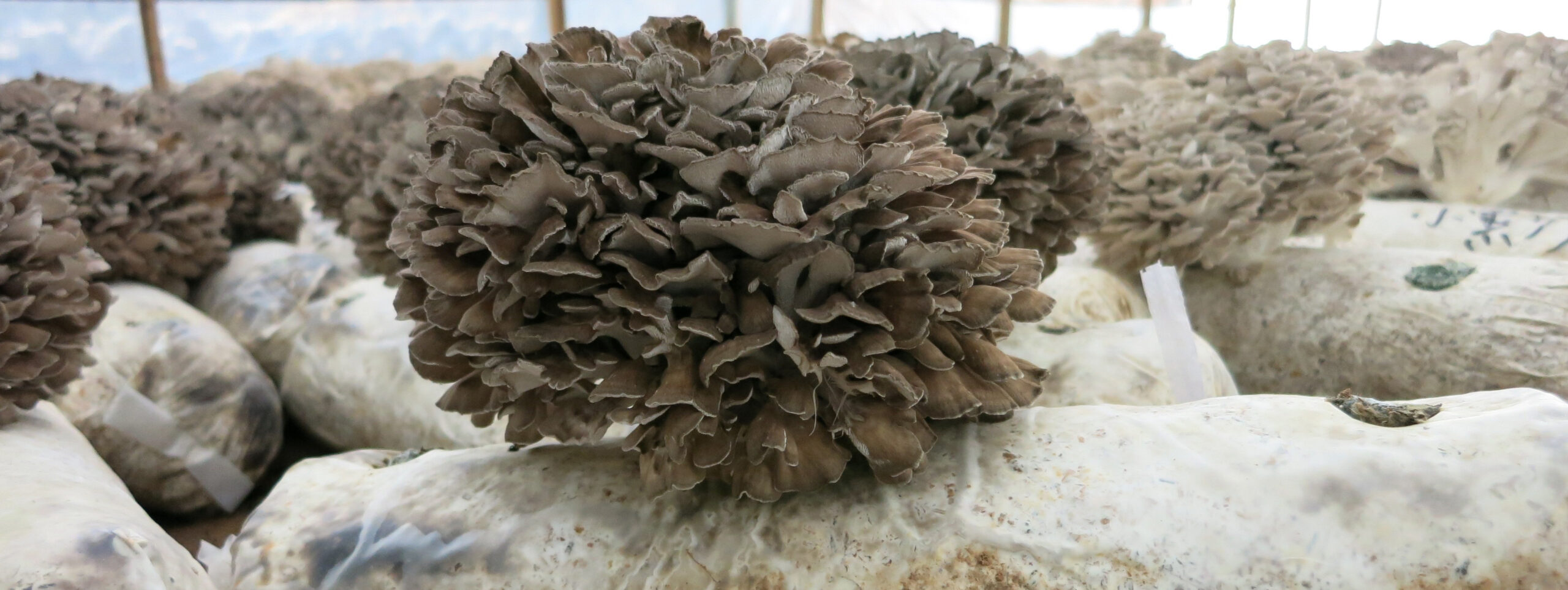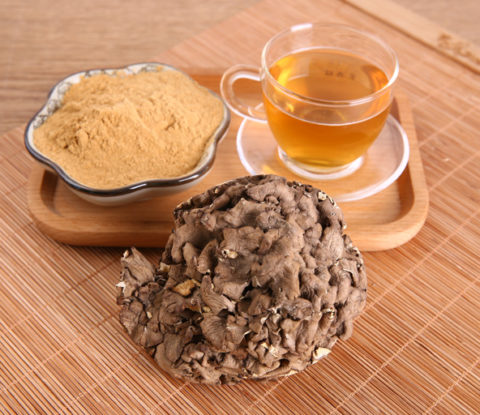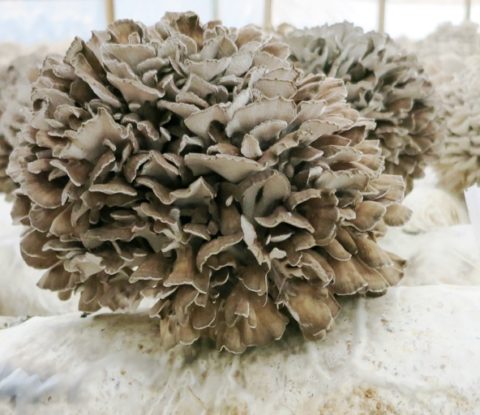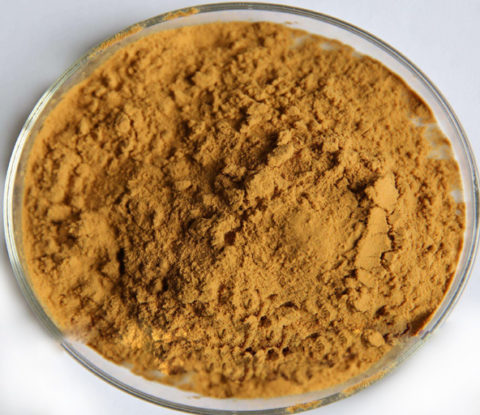
Maitake Extract Powder(Grifola frondosa)Polysaccharides 10%,30%,50% UV
Maitake Mushroom(Grifola frondosa) are rich in minerals such as zinc, potassium, calcium, and manganese, various vitamins (B2, D2, and niacin), cellulose, and various amino acids. In the 1980s, it was discovered that the main active ingredient of Grifola frondosa can enhance the immune system and is a unique component in the order of porous bacteria - protein linked polysaccharide compounds β- Glucan.
Maitake Extract Powder(Grifola frondosa) Polysaccharides 10%,30%,50% UV
【Latin Name】: Grifola frondosa (Fr.) S. F.Gray.
【Part Used】:Mycelium&fruitingbody
【Active Ingredients】: Polysaccharides, beta glucan
【Specification】: 10%,30%,50%,10:1,20:1
【Testing Method】: UV/TLC
【Appearance】: Light Brown Fine Powder
【Solubility】: 100% soluble in water Maitake Extract Powder(Grifola frondosa) Production Flowchart
Maitake Extract Powder(Grifola frondosa) Production Flowchart
Maitake mushroom raw materials – natural air drying–Coarse powder(40 mesh) -Low temperature water extraction – 1st Reflux Extraction(10 times water,2 Hrs) – 2nd Reflux Extraction8 times water,1.5 Hrs) – 3rd Reflux Extraction(6 times water,1 Hrs) – Extraction Solution-combine&Filtrate-Concentrate-Extractum-spray drying – screening – packaging – detection of physical and chemical indicators – warehousing
Specification of Maitake Extract Powder(Grifola frondosa)
| Item | Standard | Test method |
| Appearance | Brownish Yellow fine powder | Visual & Organoleptic |
| Specification | Polysaccharides 30% | UV |
| Particle size | 80 mesh | Pass 80 mesh size screen |
| Ash | <13% | 2g/525℃/3hrs |
| Moisture | <7% | 5g/100℃/2.5hrs |
| Heavy metals | As <1.0ppm Pb<2.0PPM Hg<0.2ppm Cd<1.0ppm | Atomic Absorption |
| Microbiological Control | Total Plate Count<10,000cfu/g, Yeast & Mold<100cfu/g, E.Coli<10cfu/g. |
AOAC |
| Packing | 1kg/bag, 5kg/bag, or 25kg/fiber drum (D* H, 40*50cm),
It can also be packaged according to the requirements of customers, and all the packaging materials meet the standards of Chinese Pharmacopoeia 2010. |
|
Maitake Extract Powder(Grifola frondosa)-General Introduction
The scientific name Grifola frondosa is derived from the griffin, the beast from Greek mythology with the head and wings of an eagle and the body of a lion, and frondosa, meaning leaflike. In Japanese, mai means dance and take means mushroom, thus “dancing mushroom.” It is not known whether the name came about because the fruiting bodies of adjacent fungi overlap each other, looking like nymphs or butterflies in a wild dance, or because mushroom seekers who were lucky enough to come upon maitake in the wild would dance for joy. In feudal times maitake apparently was so valued it was worth its weight in silver. Even in recent times maitake hunters have been known to jealously guard the location of their maitake grounds, sometimes revealing secret spots (where it may fruit for many years) only in a will. Maitake remains highly sought after by chefs and gourmands for its excellent taste and texture (somewhat like chicken or game hen) and for non-culinary reasons by others for its beneficial health effects.
Maitake often occurs as a heavy mass (clumps may weigh many pounds) at the base of stumps and on the roots of oaks, elms, persimmons, and other trees. Like many other fungi, maitake’s optimal growing conditions exist within a limited range for temperature, moisture, humidity, and other environmental factors. Parts of northeastern Japan are especially hospitable for maitake, although foraging and development have combined to limit its availability in the wild. Maitake can also be found in the northern temperate forests of Asia, Europe, and eastern North America. While relatively rare in the wild in Japan, maitake is not an uncommon forest mushroom in the United States andCanada, where it is known as hen of the woods (because the shape and color of its clusters bear a likeness to the tail feathers of a hen) and sheep’s head. Only rarely is it found in the western United States.
Closely related species include Grifola umbellata, which the Chinese call zhu ling or chuling, G. albicans, and G. gigantea. The Chinese sometimes include zhu ling (they use the sclerotium rather than the fruiting body) as an ingredient in herbal tonic formulas. Although zhu ling and the other Grifolas are not as thoroughly studied as maitake, they are thought to have similar compounds and health effects. Maitake cultivation is a recent development. Only within the past two decades have producers been able to switch from a reliance on foraged maitake to offering cultivated maitake. Current bottle- or bag-culture often makes use of a bed of sawdust/bran/soybean cake (in an 80:10:10 ratio) as the base.
Japanese commercial cultivation, mainly for food, started in 1981 with 325 tons. It grew to 1,500 tons in 1985, 8,000 tons in 1991, and almost 10,000 tons in 1993. Commercial maitake production worldwide may now be in excess of 40,000 tons. Within the past two decades maitake has also begun to be cultivated for use as a dietary supplement. It may be the most versatile and promising medicinal mushroom supplement, though currently less well-known than shiitake (Lentinus edodes) and reishi (Ganoderma lucidum).
Chemical Compositions of Maitake Mushroom(Grifola frondosa)
Mushrooms’ Unique and Active Compounds
Some 50 of the 38,000 species of mushrooms have been found to have medicinal properties, according to mushroom researcher Cun Zhuang, PhD. Three have been used as the source for extracts now employed clinically as anticancer d-rugs in Japan:
Kawaratake (Coriolus versicolor) is the source for PSK (Krestin). Developed in the late 1970s, PSK was the first mushroom-based anticancer drug and is now one of the most popular anticancer drugs in Japan. It is taken orally for gastric and other cancers.
Shiitake is the source for Lentinan, which has been approved since the mid-1980s to treat gastric cancer. Because of poor absorption when taken orally, this compound is best administered by injection.
Suehirotake (Schizophyllum commune) is used to derive Shizophyllan, which is used to treat cervical cancer (it also is injected). These anticancer medications, as well as many additional medicinal mushrooms such as reishi, hiratake or oyster (Pleurotus ostreatus), and enokitake (Flammulina velutipes), contain various compounds with diverse biological and therapeutic effects. The content and bioactivity of these compounds depend on how the mushroom is prepared and consumed.
Among the most important constituents are certain polysaccharides, known as beta-glucans, which are bound to proteins. PSK, Lentinan, and Shizophyllan are all forms of beta-glucan. Maitake’s prominent immuneboosting effects are thought to be due predominantly to these polysaccharides. Polysaccharides such as beta-glucans found in a number of medicinal mushrooms (as well as other polysaccharides found in medicinal herbs such as Echinacea angustifolia) are increasingly being recognized for their non-specific immunomodulatory effects. These so-called biological response modifiers can be potent antiviral and antitumor agents, not by killing viruses or cancer cells directly but by stimulating the body’s innate ability to marshal cellular defenses. Augmenting what Japanese cancer researchers have termed “intrinsic host defense mechanisms” is particularly promising because it is a property generally lacking in conventional anticancer drugs.
Chemical composition of Maitake mushroom
The polysaccharide beta-glucan is present in low quantities (0% to 0.2%) in most of the mushrooms in the Polyporaceae family (eg, reishi mushroom) and possesses antitumor activity. The D fraction of beta-glucan appears to be the most active and potent form of the polysaccharide, a protein-bound extract developed in Japan. An MD-fraction has now been described, as well, with purportedly superior activity. Both structure-functional relationship and fractionation by anion exchange chromatography of beta-glucan have been reported.
Neutral, acidic, and water-soluble polysaccharides have been extracted from maitake, and their structure has been determined. Two different glycan conformations have been obtained from the plant. The beta-1,3-glycan grifolan conformation has been elucidated using magnetic resonance spectroscopy.
Ascorbic acid analog and glycoside studies have been reported. A lectin from maitake has been isolated and characterized. In addition, a grifolisin enzyme and the enzyme phytase have been described, and lysophosphatidylethanolamine has been identified in studies examining apoptosis in neuronal cells. Structural characterization of maitake extract constituents and carbon-13 nuclear magnetic resonance analysis of the fruit body’s constituents have been conducted.
Benefits of Maitake Mushroom(Grifola frondosa)
1)The Immunopotentiating benefit
In the early 1980s Japanese mycologist Hiroaki Nanba of the PharmaceuticalUniversity at Kobe was studying various medicinal mushrooms, especially shiitake. He gradually came to the conclusion, however, that the polysaccharides in maitake have a unique structure and were among the most powerful to be studied to date, demonstrating more pronounced antitumor activity in animal tests than other mushroom extracts. Maitake also demonstrated the most promise as an orally effective immunomodulator. This made it potentially much easier to use compared to, for example, shiitake extracts that worked optimally only when administered by injection. Nanba decided to focus exclusively on maitake, and he and a number of other Japanese scientists began to extract various polysaccharides from maitake and test them for antitumor and immunomodulating potential.
In 1984 Nanba identified a fraction found in both the mycelia and the fruit body of maitake with the ability to stimulate macrophages. The fraction can be derived from maitake by treating the fruit bodies with hot water and saturating the resulting watersoluble extract to 80 percent with ethyl alcohol. The precipitate is then treated with acetic acid and an alkaline material. The resulting D-fraction is a standardized form of isolated beta-glucan polysaccharide compounds (beta-1,6 glucan and beta-1,3 glucan) and protein with a molecular weight of about 1,000,000.
In 1984 a patent was issued in Japan to Nanba and others. While other medicinal mushrooms have been shown to have bioactive beta-glucan constituents, Nanba notes that various betaglucans differ and that the beta-glucans found in the maitake D-fraction have a unique and complex structure, containing both a 1,6 main chain having a greater degree of 1,3 branches, and a 1,3 main chain having 1,6 branches. Most other mushroom-derived beta-glucans have a 1,3 main chain with 1,6 branches only. Other fractions have also been derived from maitake; for example, the X-fraction is a beta-1,6 glucan having alpha-1,4 branches. One theory is that the greater the degree of branching, the higher the likelihood the fraction will reach and activate a greater number of immune cells.
The D-fraction’s high molecular weight may also be a factor in its immunomodulating effects, according to research into antitumor activity and glucose consumption by macrophages. One investigation concluded, “These results suggest that an antitumor glucan is not always a multiple enhancer of host defense mechanisms and that a large molecular weight is required to augment multiple immunological activities.”
A subsequent study by some of the same researchers suggested that “the branching ratio and molecular weight of (1—>3)-beta-D-glucans are important factors for the production of cytokines from macrophages.” A recent review of the existing data on the mechanism of whole mushrooms and isolated mushroom compounds, particularly certain beta-glucans, concluded the antitumor mechanisms of several species, including maitake, are mediated largely by T-cells and macrophages. According to the researchers, “Despite the structural and functional similarities of these glucans, they differ in their effectiveness against specific tumo-rs and in their ability to elicit various cellular responses, particularly cytokine expression and production.”
2).Antitumor effect
Maitake fractions in particular seem to have a specific antitumor action, potentially slowing the growth of tumors in the colon, lungs, stomach, liver, prostate, brain, and other organs. Researchers of maitake have identified several ways that maitake can counter cancer: (1) by protecting healthy cells from becoming cancerous; (2) by helping to prevent metastasis; and (3) by slowing or stopping the growth of tumors. A fourth potential use of maitake is to enhance the benefits of chemotherapeutic d-rugs while reducing the undesirable side effects.
A study by Masuda et al. demonstrated that D-fraction of Grifola frondosa in combination with cisplatin (i.e., CDDP, a widely used anticancer d-rug with serious side effects), significantly enhanced antitumor and antimetastatic activity compared to CDDP alone. Although CDDP treatment resulted in decreased total weight of the body and the spleen in particular, D-fraction reduced weight loss in comparison to control treatments that lacked maitake exposure. In addition, CDDP-treated mice with D-fraction showed a relatively lower loss of immunocompetent cells such as macrophages, dendritic cells (DCs), and natural killer (NK) cells. D-fraction in combination with CDDP not only increased the number of immunocompetent cells, but also induced interleukin (IL)-12p70 production by splenocytes, resulting in increased NK cell activity. These results indicate that D-fraction exhibits antitumor and antimetastatic activity by strongly enhancing innate immunity.
Moreover, this study shows that D-fraction can reduce nephrotoxicity, which is one of the major dose-limiting toxicities of CDDP. Because D-fraction in combination with CDDP not only enhances antitumor and antimetastatic activity but also reduces CDDP-induced myelotoxicity and nephrotoxicity, the combined treatment of D-fraction with cisplatin should be useful in the treatment of cancer.
Lin et al. used a colony forming units assay of normal mice to test the dose-response to maitake D-fraction on bone marrow suppression caused by the chemotherapeutic d-rug doxorubicin (DOX). Normal mouse bone marrow CFU-GM progenitor cell activity was significantly increased in the presence of D-fraction in the dose range of 50–100 Ag/ml. The study further showed that toxicity of DOX on bone marrow is attenuated by D-fraction. Even without DOX, bone marrow cell viability is dramatically decreased within 24 h without the support of in vitro growth factor. Moreover, Lin and colleagues observed that D-fraction protected the bone marrow progenitor cells from irreversible damage associated with prior DOX induced toxicity, suggesting that D-fraction supports maintenance or viability of bone marrow progenitor cells in the face of DOX toxicity. Furthermore, D-fraction treatment promoted the recovery of hematopoiesis from bone marrow following pretreatment with DOX. These data indicate that D-fraction directly affects bone marrow cell survival from DOX and that D-fraction of maitake has the potential to reduce hematopoietic suppression induced by chemotherapy.
Kodama et al. investigated the benefits of D-fraction and mitomycin-C (MMC), an anticance-r agent with deleterious side effects, in tumor-bearing mice. They demonstrated that by enhancing the T helper (Th)1-dominant response, D-fraction decreases the amount of MMC required to manage cancer. Although further studies are required to clarify whether combined therapy using D-fraction is effective, this study has indicated a potential benefit when applied with MMC in the therapy of patients with cancer.
The sulfated derivate (S-GAP-P) of water-insoluble polysaccharide produced by maitake was tested with the anticancer chemotherapeutic agent cyclophosphamide (CTX). S-GAP-P exhibited distinct anti-proliferative effects on human gastric carcinoma SGC-7901 cells and induced apoptosis in a dosedependent manner, but had no effects on mouse sarcoma S180 cells. The in vivo experiments showed that S-GAP-P significantly inhibited tumo-r growth and enhanced macrophage phagocytosis in S180-bearing mice. It is noteworthy that S-GAP-P could accelerate the antitumor activity of CTX and partially reverse the immunocompetence induced by CTX.
A result reported by Matsui et al. suggests that, in addition to activating immunocompetent cells, D-fraction also has an antitumor effect, i.e., the reduction of carcinoma angiogenesis. However, an earlier study reported that angiogenesis is essential for the carcinoma cells as the means of securing nutrient composition, oxygen supply, and emission of metabolic wastes; thus, the antitumor effect of D-fraction is caused by the reduction of angiogenesis. Moreover, they showed that the TNF-α produced by macrophages causes direct damage to carcinoma cells as well as stimulating macrophages to produce a vascular angiogenesis factor. Matsui and colleagues suggest that D-fraction enhances TNF-α production by macrophages, which implies that induction of vascular angiogenesis and the antitumor effect of D-fraction are closely related processes.
3).Cardiovascular related benefits
Diabetes
At least two studies have suggested antidiabetic effects for maitake. In one, Japanese researchers fed genetically diabetic mice a diet containing 20-percent whole maitake powder for eight weeks. The maitake was shown to inhibit a rise in blood glucose. The researchers also observed glucose-lowering activity in the X-fraction. They concluded that their findings suggest maitake is effective at lowering blood sugar in diabetic animals. A subsequent study by Kubo and Nanba, also done on genetically diabetic mice, sought to identify the active material and examine its mechanism. Again, maitake inhibited significant blood glucose increase, with the antidiabetic mechanism of maitake or the X-fraction being directly associated with insulin receptors. According to the researchers, their results suggest maitake could increase insulin sensitivity.
Blood pressure
Powdered whole maitake has been shown in animal studies to lower blood pressure and to prevent blood pressure increase. For example, the blood pressure of spontaneously hypertensive rats (SHR) was significantly reduced by maitake powder feeding (5percent of the diet) for nine weeks. A similar feeding protocol over eight weeks, beginning when the rats were 10 weeks old and had wellestablished high blood pressure, was also successful. The researchers concluded the results support the contention that maitake not only suppresses the development of hypertension, but also lowers already elevated blood pressure. In a third study by some of the same researchers, spontaneously hypertensive rats were fed a five-percent maitake powder diet for nine weeks and compared to control and shiitake-fed rats. Adverse histological changes, including necrosis of the medial smooth muscle cells and fatty liver development, were essentially the same in the control and shiitakefed rats. On the other hand, except for large amounts of glycogen observed in the livers, the maitake-fed rats were normal in all respects.
According to the researchers, “Dietary maitake seems to play an important role in preventing the histological degenerative changes in SHR and thus may imply some benefits to be gained through blood pressure reduction and an improvement of lipid metabolism.”
Cholesterol and Triglycerides
A number of studies have examined maitake’s effects on serum lipids, including cholesterol and triglycerides, with somewhat mixed results. In a study published in 1988, dried and powdered maitake, as five percent of the feed of spontaneously hypertensive rats, significantly lowered levels of VLDL and total serum cholesterol.42 Another study conducted on spontaneously hypertensive rats fed a diet consisting of five-percent maitake powder for eight weeks, however, found no difference in plasma total and free cholesterol, tri-glyceride, and phospholipid levels compared to controls. (Shiitake did not reduce blood pressure but did lower these other factors.)40 More recently, Japanese scientists fed rats a high-cholesterol diet and measured the effects of fortifying the diet with 20-percent maitake dried powder. The researchers found that maitake inhibited fat accumulation in the liver and caused an initial reduction in total cholesterol. By day 25, however, the difference in total cholesterol was no longer significant. The maitake-fed rats did maintain baseline values for HDL, which usually decrease on a high-cholesterol diet. In a subsequent study with a similar protocol, maitake-fed rats experienced significant and lasting reductions in serum cholesterol and triglycerides, and a similar maintenance of HDL levels. One observer noted the inconsistent findings may be due to lack of standardization of maitake powder in the studies, and the fact that the lipid lowering constituent apparently has not yet been completely defined.






